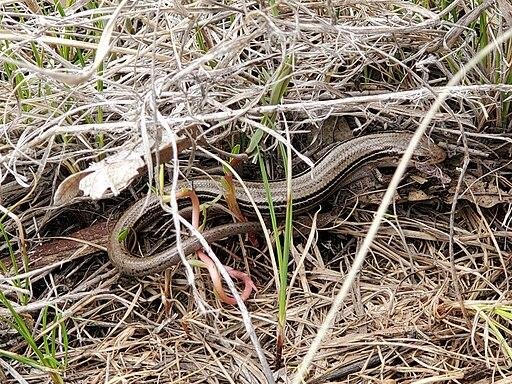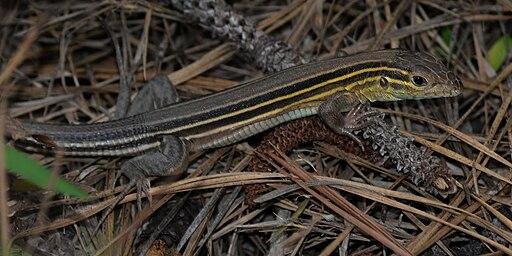By Misi Stine, Environmental Educator and member of the MN Herpetological Society
Although there are about 150 native and non-native species of lizards found in North America, only three are hardy enough to survive in the Bold North, also known as Minnesota. In fact, the farther north you go, the conditions become less favorable to reptiles and amphibians because of the harsh climate, and the overall number and diversity of species decline.
So, which three species are we lucky to have in Minnesota?
First is the Northern Prairie Skink (Plestiodon septentrionalis), which has the most extensive range and is most commonly seen here. It can be found throughout much of the state, except for the bluff lands of the southeast and the arrowhead region. The habitat they are found in includes grasslands, oak savannas, and pine barrens along river banks and in grassy openings in their preferred habitat. Being ectotherms (a critter that cannot regulate its body temperature), they will burrow below the frost line and spend winter there.
Their total length, including their tail, is 5¼ to 8¾ inches. The body is marked with three broad tan-to-brown stripes separated by two narrower black stripes running down the body and tail. However, the stripes fade as they approach the head. As in many species, the male is more colorful, sporting a bright orange color on the lips, neck, and head during mating season.
Prairie Skink (Plestiodon septentrionalis) Chris Friesen, CC BY 4.0 <creativecommons.org/licenses/by/4.0>, via Wikimedia Commons
Second, is the Common Five Lined Skink (Plestiodon fasciatus); in other parts of its range, it is typically found in humid woodlands and woodlots with logs, stumps, and decaying leaf litter. However, in Minnesota, they are found in limited areas, including the Minnesota River Valley along granite outcroppings, in southeastern Minnesota in prairie bluffs, and the limestone outcroppings associated with nearby deciduous forests. Their overwintering strategy differs from the Prairie Skink; they look for rock cracks and fissures that go deep enough to allow them to get below the frost line for the winter.
The Common Five-Lined Skink's back has five yellowish stripes (hence the name) extending onto its head, creating a Y, a feature that helps distinguish it from the Prairie Skink. Both juvenile skinks and adult females tend to be black, whereas males are brown to gray, and the stripes may be less visible or absent when the males mature. As with the Prairie Skink, they display bright colors during mating season. In this species, the colors can range from orange to red on the cheeks, lips, nose, and throat. Its total body length, including its tail, varies from 5-8 inches.
Common Five Lined Skink (Plestiodon faciatus). Will Brown, CC BY 2.0 <creativecommons.org/licenses/by/2.0>, via Wikimedia Commons
Last but not least, the Six Lined Racerunner (Aspidoscelis sexlineata), is not a skink but from the Teiidae family, which includes new world lizards, the racerunner, and whip tail lizards. They are found only in a small area in southeastern Minnesota in seven counties. They are found in open sandy or rough gravel-covered areas without much vegetation, sand outwashes in river flood plains, and prairies on the south-facing side of the bluffs. Like the Prairie Skink, they also spend their winters in burrows. They dig in loose soil that will allow them to get down below the frost line.
The Racerunner is about 9 inches in total length, including the tail. The tail of this species is long compared to the Minnesota Skinks, ranging from approximately 6-7 inches. The markings on the body consist of six stripes ranging from light yellow to yellowish-green that run the length of the body on the dorsal, or topside, from behind the eyes to where the tail begins. The body is varying shades of brown with bright green or yellow on the sides.
Six Lined Racerunner (Aspidoscelis sexlineata). William L. Farr, CC BY-SA 4.0 <creativecommons.org/licenses/by-sa/4.0>, via Wikimedia Commons
All three of these species have some things in common:
They are active from about May-September each year.
They can break off their tails and the detached piece will continue to wiggle when grabbed by a predator, giving them a chance to escape. The tail will regrow over time but is not as long when it grows back, and has a different color from the original tail.
They lay eggs with the number in each clutch varying between 1-6 for Racerunners, and 5-13 in the two other skink species.
They are all insectivores consuming small arthropods, which include crustaceans, insects, and arachnids. Some of their favorites include grasshoppers, spiders, crickets, ants, flies, beetles, moths, snails, and roaches.
The juveniles have blue to blue-green tails, which is an adaptation to help them draw the attention of predators to grab ahold of the tail and allow them time to get away. When you are young and inexperienced having an additional tool in your predator defense toolbox is helpful.
Minnesota lizards are fast and if the temperatures are warm, you will not likely catch them.
If you do happen to catch a glimpse of these lizards, you are lucky and even luckier if you can catch them or snap a quick photo!
References
James H Harding, D. A. (2017). Amphibians and Reptiles of the Great Lakes Region. pp. 238-250.
John J. Moriatry, C. D. (2014). Amphibians and Reptiles in Minnesota. pp. 181-197.
Reptiles and Amphibians of Minnesota. (n.d.). Retrieved from Minnesota Department of Natural Resources: https://www.dnr.state.mn.us/reptiles_amphibians/index.html
Schik, K. (n.d.). Minnesota's 3 Little Lizards. Retrieved from Friends of the Mississippi: https://fmr.org/minnesotas-three-little-lizards
Sheldon, A. B. (2006). Amphibians and Reptiles of the North Woods. pp. 102-109.


